Marin Marin
-
- Volvo Ocean Race: Zero Emission Shipping Meets High-Level Sports Maritime Reporter, Feb 2018 #50
MARIN’s research work in Wind (Assisted) Ship Propulsion and our mission to make ships cleaner, safer and smarter is all coming into play as they assist team AkzoNobel with their Volvo Ocean Race challenge.By Rogier Eggers, MARINMARIN’s research work in Wind (Assisted) Ship Propulsion and our mission to make ships cleaner, safer and smarter is all coming into play as they assist team AkzoNobel with their Volvo Ocean Race challenge.Over the years MARIN has had some very successful involvement with racing sailing yachts. One example was the support for the Australia II team that was the first non-US team to win the Americas Cup. Another more recent example is the ABN AMRO team winning the Volvo Ocean Race when canting keel boats were first introduced. Now the AkzoNobel team, skippered by Simeon Tienpont, has approached MARIN to support them as they enter the Volvo Ocean Race. This time, the research fits in a different context and involves our work in Wind (Assisted) Ship Propulsion (WASP). It supports our long-term objective for “cleaner” ships and the development of zero- emission shipping, not only for sailing yachts but for merchant ships as well.A specific field of research that receives relatively little attention, both in wind-assisted cargo ships and sailing yachts, is the impact of real operational conditions in wind and waves. Therefore, we decided to focus our research and added value for Simeon’s team on determining the performance of his yacht in real operational conditions.Wind propelled modelFor this purpose a set-up was developed to model wind propelled vessels in MARIN’s Seakeeping and Manoeuvring Basin to perform a short validation, model test programme. This was followed by a more extensive calculations’ programme supported by the validation data. In this way we provided valuable input to the sailors, while the set-up, calculation methodologies and the lessons learned are applicable for wind-assisted cargo ships as well.It should also be noted that the Volvo Ocean 65 is a ‘one-design boat’. The team receives the boat from the race organisation and is not allowed to make changes. This means that the predictions cannot be used for design changes, so you may well ask what the predictions are for? First of all, the crew still has many different ways to sail the boat in the fastest possible manner. And because training days are limited, they will not encounter all the conditions they will face during the race to check and optimise their performance in practice. This is precisely why the predictions are used - to have a benchmark, or starting point for the best setting for each condition. Furthermore, besides sailing fast, you should sail the best route. The work MARIN is conducting will give insight into the performance in waves, which should lead to better routing decisions.To this end, the following work is carried out:• ReFRESCO Computational Fluid Dynamics simulations (RANS) in calm water, to have calculations with the best possible accuracy. At the same time, these calculations are too costly and time consuming to span all operational parameters.• PANSHIP potential flow simulations in calm water to extend the parameter space covered by the ReFRESCO simulations (after a comparison with the ReFRESCO results)• Scale model tests in waves to determine the performance, and in particular the added resistance in waves (RAW). Again, due to cost this is only done for a small number of conditions.• PANSHIP simulations in waves to extend the parameter space as covered by the model tests.• Onboard monitoring to validate the simulations and determine if and where corrections need to be made to the laboratory” experiments.• Additionally, work is planned to calculate the actual wave conditions based on the measured motions on board. This will help the crew decide on which added resistance (and associated performance) is applicable at that moment. Furthermore, the actual conditions may be used to benchmark the metocean forecasts to further optimize the routing.The team itself complemented the above with performance analysis of all the training, preparatory races and crew monitoring.Added value in ‘raw’ resistanceIn this project MARIN pushed the boundaries through extensive seakeeping tests and simulations, which also account for added resistance. A dedicated test set-up and carbon model was built to achieve a low weight of 90 kg with a length of just under 4 m, while having the (approximate) correct stability, righting moment and inertia at the same time. During the tests the canting keel could be set to various angles and the rudders were actively controlled by an autopilot. A moveable horizontal beam was fitted on the two masts to change the connection point of the winch set-up. In this way the aerodynamic centre of effort could be varied in a large range of longitudinal and vertical locations.In the winch set-up lines were used to apply the aerodynamic loads from the sails. The required driving force was recalculated each time-step, accounting for the following instantaneous values:• Apparent wind angle over deck• Apparent wind speed over deck• Heel• Roll velocity (estimate for roll damping)The winches were controlled based on the required driving force. By using two winches, the force vector can move in any direction between them. This accounts for diversions in course, speed and unexpected heel angles. As far as we know this set-up is unique in the world.Applications for wind-assisted ships in this same test set-up could be:• The combined (steady) heel and (dynamic) roll and the influence of sails in this• The course keeping ability in stern quartering wind and waves (probably with very little propeller flow over the rudders and large roll and yaw wave excitation)• The possibility to meet zig-zag IMO requirements.After a little tuning, the PANSHIP simulations corresponded very well with the test results. The overall calculations matrix yielded the added resistance as a function of wave height, relative direction, period, ship speed, heel angle and various boat settings. This is a much more detailed description compared to the typical empirical calculation with only two or so parameters. The variations within the more extensive parameter space can in fact be very relevant as shown in Figure 2. Although specific numbers will be shared only after the race, it can clearly be seen that the added resistance varies significantly with heading (green versus red line).MARIN was able to provide valuable information to team AkzoNobel to calibrate their performance in calm water and to make better routing decisions to allow for the performance degradation in seas. At the same time, the project has yielded spin-offs with lessons learnt and an improved test set-up that can also be used for wind-assisted vessels.
About the AuthorRogier Eggers is senior project manager at the business unit Ships at MARIN, the Maritime Research Institute Netherlands.As published in the February 2018 edition of Maritime Reporter & Engineering News: https://magazines.marinelink.com/nwm/MaritimeReporter/201802/
-
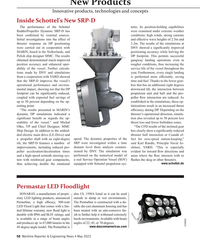 )
May 2023 - Maritime Reporter and Engineering News page: 58
)
May 2023 - Maritime Reporter and Engineering News page: 58thruster response on DP positioning 3.2m. The results of the simulations at were carried out in cooperation with DNV showed a signi? cantly improved MARIN, based in the Netherlands, and positioning accuracy while halving the Polish ship designer MMC. The results DP footprint. This permits successful
-
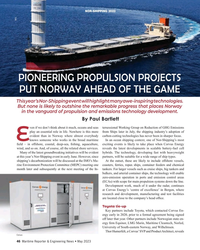 )
May 2023 - Maritime Reporter and Engineering News page: 46
)
May 2023 - Maritime Reporter and Engineering News page: 46En- ergy early in 2020, prior to a formal agreement being signed off later that year. Other partners include Norwegian state en- ergy ? rm Equinor, LMG Marin, Maritime Cleantech, Norled, University of South-eastern Norway, and Wilhelmsen. Thor Humerfelt, a Corvus’ SVP and Product Architect, reveals Corvus 46
-
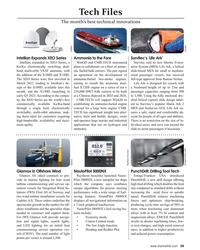 )
February 2023 - Maritime Reporter and Engineering News page: 39
)
February 2023 - Maritime Reporter and Engineering News page: 39Expands XEO Series Ammonia to the Fore Survitec’s ‘Life Ark’ Intellian expanded its XEO Series, a WinGD and CMB.TECH announced Survitec said its new Marine Evacu- Ku/Ka electronically switching dual- plans to collaborate on a ? eet of ammo- ation System (MES) Life Ark, a helical band multi-orbit VSAT
-
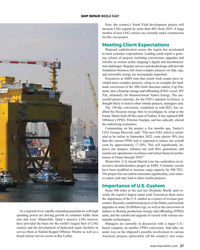 )
January 2023 - Maritime Reporter and Engineering News page: 27
)
January 2023 - Maritime Reporter and Engineering News page: 27projects, managers said. The 150-day conversion, completed in mid-2022, has en- abled the Houston energy ? rm to recon? gure its setup at the Etame Marin ? eld off the coast of Gabon. It has replaced BW Offshore’s FPSO, Petroleo Nautipa, and has radically altered the underlying economics. Commenting
-
 )
December 2022 - Maritime Reporter and Engineering News page: 38
)
December 2022 - Maritime Reporter and Engineering News page: 38all-electric Massterly, a joint venture between he Wilhelmsen group containership. and the Kongsberg group, will operate Yara Birkeland from Designed by Marin Teknikk and built at Vard’s shipyard its monitoring and operations center in Horten. SEYMOUR SUN & GROUSE SUN Dual Fuel Methanol Delivered in January
-
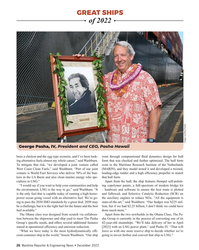 )
December 2022 - Maritime Reporter and Engineering News page: 26
)
December 2022 - Maritime Reporter and Engineering News page: 26developed a joint venture called went to the Maritime Research Institute of the Netherlands West Coast Clean Fuels,” said Washburn. “Part of our joint (MARIN), and they model tested it and developed a twisted, venture is World Fuel Services who deliver 70% of the bun- leading-edge rudder and a high ef?
-
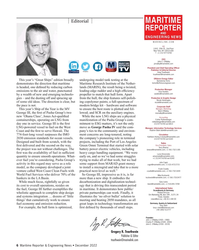 )
December 2022 - Maritime Reporter and Engineering News page: 6
)
December 2022 - Maritime Reporter and Engineering News page: 6NEWS M A R I N E L I N K . C O M HQ 118 E. 25th St., 2nd Floor New York, NY 10010 USA T +1 212 477 6700 CEO John C. O’Malley [email protected] President and Chief Operating Of? cer Publisher & Editorial Director @ShipNews Greg Trauthwein [email protected] Offshore Energy
-
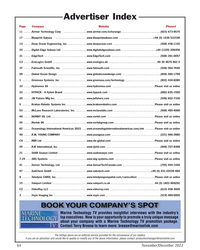 )
November 2022 - Marine Technology Reporter page: 64
)
November 2022 - Marine Technology Reporter page: 64. . . . . . . . . . . . . .www.voyis.com . . . . . . . . . . . . . . . . . . . . . . . . . . . . . . . . . . .(519) 489-0005 BOOK YOUR COMPANY’S SPOT vie Te Marine Technology TV pr rovides insightful inter ews with the industry’ Marine Technology TV provides insightful interviews with the industry’s s top executives
-
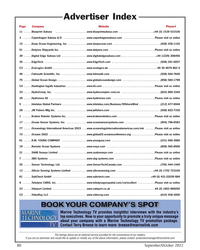 )
September 2022 - Marine Technology Reporter page: 80
)
September 2022 - Marine Technology Reporter page: 80. . . . . . . . . . . . . . .www.videoray.com . . . . . . . . . . . . . . . . . . . . . . . . . . . . . . . .(610) 458-3000 BOOK YOUR COMPANY’S SPOT vie Te Marine Technology TV pr rovides insightful inter ews with the industry’ Marine Technology TV provides insightful interviews with the industry’s s top executives
-
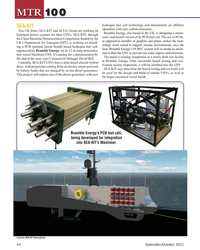 )
September 2022 - Marine Technology Reporter page: 44
)
September 2022 - Marine Technology Reporter page: 44SEA-KIT operation with zero carbon emissions. Two UK ? rms, SEA-KIT and ACUA Ocean are working on Bramble Energy, also based in the UK, is designing a marin- hydrogen power systems for their USVs. SEA-KIT, through ized, customized version of its PCB fuel cell. The use of PCBs, the Clean Maritime Demonstration
-
 )
April 2022 - Maritime Reporter and Engineering News page: 54
)
April 2022 - Maritime Reporter and Engineering News page: 54CO2 emissions by up to 30%. maximum dredging depth of 95 feet. fore increases the estimated life. bit.ly/3Lyvpog bit.ly/3r28Mkx bit.ly/3j1zjdq MARIN Autoship Newport Shipping/Marine Service Containerized LNG Crash Barriers for Wind Farm Stability for Jack-Ups Marine Service GmbH and New- Dutch maritime
-
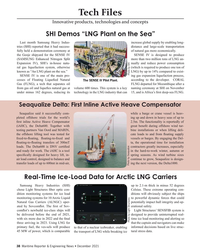 )
December 2021 - Maritime Reporter and Engineering News page: 38
)
December 2021 - Maritime Reporter and Engineering News page: 382.5m. The functionality is reportedly of (iAHC), the Delta600. Together with great bene? t during offshore wind tur- testing partners Van Oord and MARIN, bine installations or when lifting deli- the offshore lifting tool was tested for cate loads to and from ? oating supply ? xed-to-? oating,
-
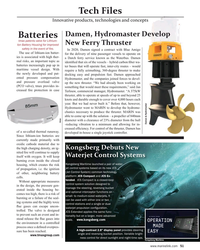 )
June 2021 - Maritime Reporter and Engineering News page: 51
)
June 2021 - Maritime Reporter and Engineering News page: 51up to and beyond 25 knots and durable enough to cover over 4,000 hours each year. But we had never built it.” Before that, however, Hydromaster went to MARIN to develop the hydrome- chanics necessary to produce the thruster. MARIN was able to come up with the solution – a propeller of 840mm diameter with
-
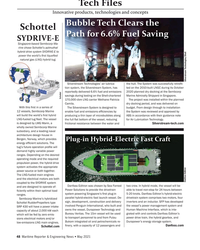 )
May 2021 - Maritime Reporter and Engineering News page: 48
)
May 2021 - Maritime Reporter and Engineering News page: 48during its October reportedly delivered 6.6% fuel and emissions 2020 planned dry docking at the Sembcorp savings during testing on the Shell-chartered Marine Admiralty Shipyard in Singapore. Schottel 170,000 cbm LNG carrier Methane Patricia The project was installed within the planned Camila. dry docking
-
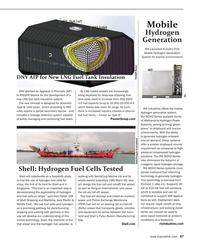 )
May 2021 - Maritime Reporter and Engineering News page: 47
)
May 2021 - Maritime Reporter and Engineering News page: 47Mobile Hydrogen Generation RIX Launches Industry-First Mobile Hydrogen Generation System for marine environments DNV AIP for New LNG Fuel Tank Insulation PASSER Marine DNV granted an Approval In Principle (AIP) As LNG fueled vessels are increasingly to PASSER Marine for the development of a being
-
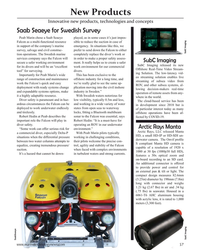 )
January 2021 - Marine Technology Reporter page: 57
)
January 2021 - Marine Technology Reporter page: 57New Products Innovative new products, technologies and concepts Saab Seaeye for Swedish Survey Peab Marin chose a Saab Seaeye played, as in some cases it’s just impos- Falcon as a multi-functional resource sible to reduce the suction in case of in support of the company’s marine emergency. In situations
-
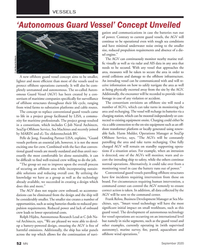 )
September 2020 - Marine News page: 52
)
September 2020 - Marine News page: 52underwater noise owing to the smaller size, reduced propulsion requirements and absence of a die- sel engine.” The AGV can continuously monitor nearby marine traf- ? c visually as well as via radar and AIS data in any area that needs to be secured. With any vessel that approaches the area, measures will
-
 )
August 2020 - Maritime Reporter and Engineering News page: 55
)
August 2020 - Maritime Reporter and Engineering News page: 55genera- of $468 million, it is the largest single diamond mining is done in open-cast tion, distribution and variable speed investment ever made in the marine mines, however, with the land-based drive propulsion systems, the solution diamond industry. It will deploy subsea output in Namibia expected
-
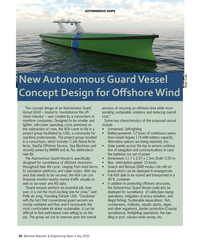 )
July 2020 - Maritime Reporter and Engineering News page: 40
)
July 2020 - Maritime Reporter and Engineering News page: 40options are being explored, too. tects, SeaZip Offshore Service, Sea Machines and • Solar panels across the top to ensure continua- recently joined by MARIN and eL-Tec elektrotech- tion of navigation and communications in case niek BV. the batteries run out of power The Autonomous Guard Vessel is specifcally
-
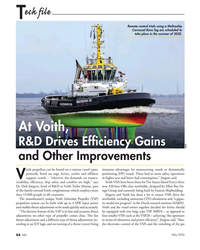 )
May 2020 - Marine News page: 44
)
May 2020 - Marine News page: 44, ship safety and comfort are high,” says Voith VSPs have been chose for The Staten Island Ferry’s three Dr. Dirk Jürgens, head of R&D at Voith Turbo Marine, part new 320-foot Ollis class newbuilds, designed by Elliot Bay De- of the family-owned Voith conglomerate which employs more sign Group and currently
-
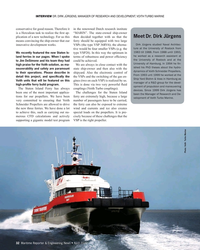 )
April 2020 - Maritime Reporter and Engineering News page: 32
)
April 2020 - Maritime Reporter and Engineering News page: 32INTERVIEW DR. DiRk JüRgens, ManageR Of ReseaRCH anD DevelOPMent, vOitH tuRBO MaRine conservative for good reason. Therefore it in the renowned Dutch research institute is a Herculean task to realize the frst ap- “MARIN”. The state-owned ship-owner Meet Dr. Dirk Jürgens plication of a new technology.
-
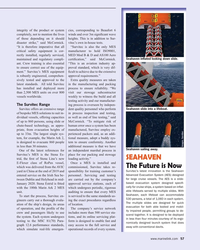 )
March 2020 - Maritime Reporter and Engineering News page: 57
)
March 2020 - Maritime Reporter and Engineering News page: 57, from evacuation heights of manufactured, Survitec employ ex- up to 33m. The largest single sys- perienced packers and, as an addi- tem, for example, the Marin Ark 2, tional measure, adopt a buddy sys- is designed to evacuate 860 people tem to ensure conformity. Another Images: Survitec in less than 30
-
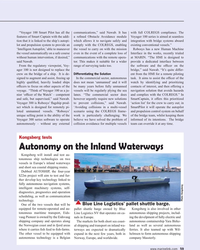 )
February 2020 - Maritime Reporter and Engineering News page: 59
)
February 2020 - Maritime Reporter and Engineering News page: 59event of a complete loss of Interface in the works, recently trialed without human intervention, if desired,” communications with the remote opera- at MARIN. “The HMI is designed to said Nawab. tor. This makes it suitable for a wider provide a dedicated interface between From the regulatory viewpoint
-
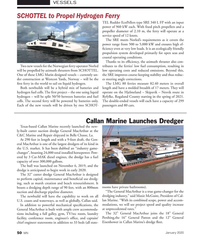 )
January 2020 - Marine News page: 50
)
January 2020 - Marine News page: 50consumption, resulting in will be propelled by azimuth thrusters from SCHOTTEL. low operating costs and reduced emissions. Beyond this, One of these LMG Marin designed vessels – currently un- the SRE improves course-keeping stability and thus reduc- der construction at Westcon Yards, Norway – will be the
